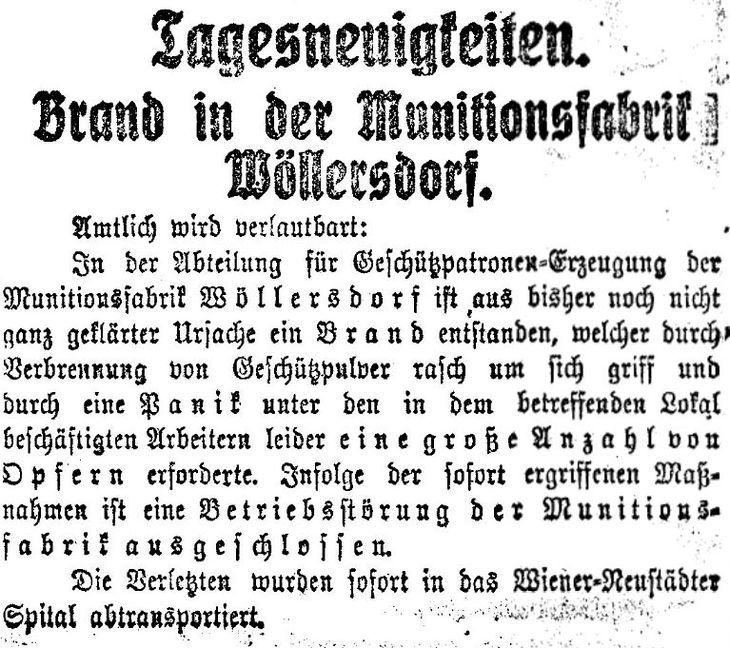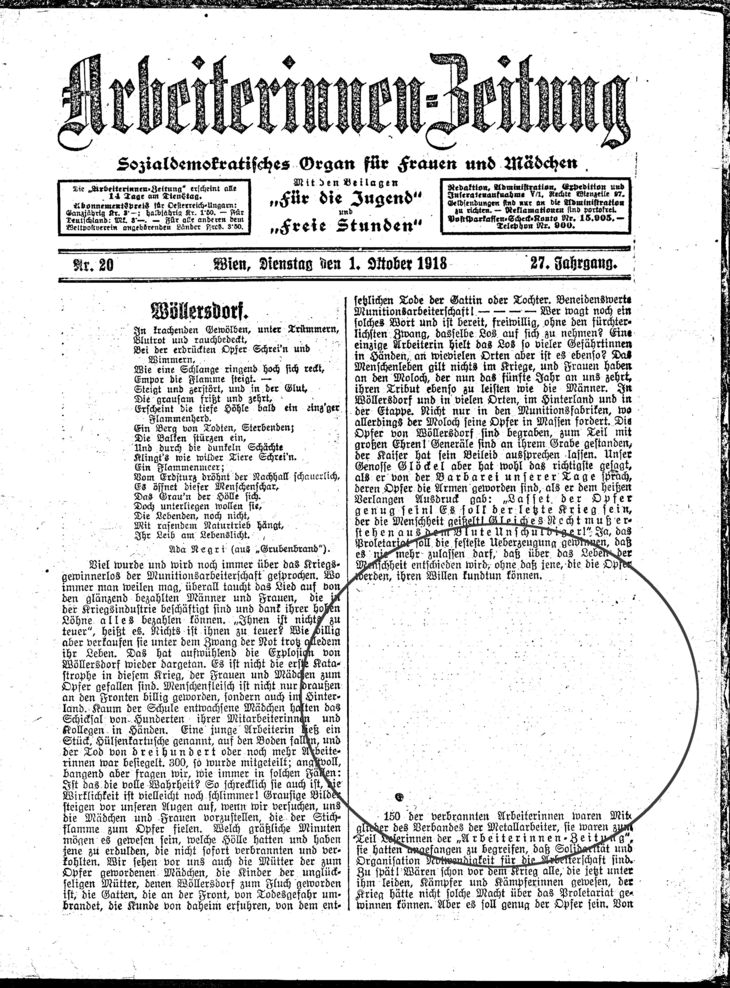By Barbara Klaus, University of Innsbruck
More than one hundred years ago, the First Word War (1914-1918) shook the European nations. The so-called ‘Great War’ developed into the first ‘all-out war’ or ‘total war’. It captured all parts of society and involved the civil population in warfare more than ever before. This lead to profound changes in society, and yet the image of the heroic fighting soldier dominated the public perception of the war. As a result of the first ‘total war’, the so-called ‘home front’ emerged, as a pendant to the war front, in all warring countries. Both fronts were closely related to each other, but in contemporary discourse, the ‘home front’ had a mainly female connotation.
Propaganda and patriotism
Furthermore, patriotic collection campaigns, e.g. ‘Gold gab ich für Eisen’ (‘I gave gold for iron’), Kriegsnagelungen (Nail Men) and door-to-door-collections of metal and clothes, were conducted at the ‘home front’ during the war. This is another aspect of the Great War: the unprecedented linkage between the terms ‘propaganda’ and ‘patriotism’. For example, the entire picture production (i.a. press photographs, picture postcards and posters) during the war can perceived as an expression of patriotism. At the same time, the first ‘media war’ erupted on all sides. Means of communication were gutted for propagandistic purposes. It has to be noted that not all metal collections were well received by the general public. Especially the confiscation of most church bells, which were melted down and re-used as war material (e.g. cannons and ammunition), lead to a loss of confidence in the monarchy and the church.
The ‘dark sides of war’
Numerous negative effects accompanied the war, both on the war front and on the ‘home front’. These negative impacts can be defined as the ‘dark sides of war’ and they include destruction, death, disability, war widows, orphans etc. For example, more than nine million soldiers died during the war. Of these, over one million soldiers in Austria-Hungary and over two million in Germany lost their lives in the battlefield. It is presumed that between 180.000 and 190.000 Austrian soldiers were killed or went missing in action between 1914 and 1918. Especially at the eastern front soldiers also died of diseases, for example cholera, dysentery and typhus. However, the civil population at the home front also suffered from constantly declining living conditions and food shortages. Additionally, due to the absence of fighting men, women had to replace the male population in civil workplaces. They became an irreplaceable workforce for the arms industry. Due to low security standards, long working hours and food shortages the female factory workers suffered from malnutrition, diseases (e.g. tuberculosis) and poisonings (e.g. hydrocyanic acid and picric acid – essential ingredients of explosives). Furthermore, accidents in the factories accumulated. However, figures on civilian victims in Austria-Hungary were never properly established. The war also left behind a challenging number of invalids, war widows and orphans. This leads to the main research questions.
Research Questions
- How are the ‘dark sides of war’ represented in news coverage during the war?
- What kind of changes and/or shifts can be traced in newspapers of the time?
- Which front (‘home’ or war front) is favored in the news coverage of the war?
- What kind of propagandistic and patriotic purposes do these ‘dark sides of war’ serve in the newspapers?
Example I: Fire at the munitions factory Wöllersdorf (18 September 1918)
In Wöllersdorf, Lower Austria, a massive fire catastrophe occurred in September 1918. Over 400 people – mainly young girls and women – were killed during this fire in building No. 143 at the local munitions factory; about 35 people survived. The factory was one of the most important munition factories of the k.u.k. arms industry before and during the First World War. In this building, especially women and young girls weighted gunpowder, filled it into linen bags and combined them with detonators. Because of the precarious situation at the end of the war, the production had to be as effective and efficien as possible. Therefore, many safety precautions were abandoned and rules and regulations for occupational safety suspended.

Just prior to noon, the fire was caused by a cartridge case that fell to the floor and generated a flash, which then rapidly set to fire the surrounding gunpowder. The number of victims was so high because most of the exits were closed to prevent the workers from leaving the factory early for lunch. It wasn’t the first incident at the munitions factory in Wöllersdorf. In 1913, three workers died during an explosion in one of the factory’s buildings. Four years later, in 1917, three gunpowder magazines detonated at night near Wöllersdorf. The explosion was widely heard and caused damage to buildings many kilometers away.
Initially, the military administration tried to minimize the damage in public opinion and censored the newspaper reports about the catastrophe in September 1918. A few days later, an insight into the true extent of the tragedy was given. Taking a look into the newspaper articles about the fire at the munitions factory in Wöllersdorf, it is obvious that official entities had a huge influence on the press coverage about the accident. In the first two days after the fire catastrophe, only short articles were published, which often contained similar (official) information about the fire. Later articles filled up to one newspaper page. Some of them contained so-called ‘white spots’, which were caused by censorship. Then, 103 articles in 37 different Austrian newspapers dealt with the civil disaster. This broad range of newspapers underlines the already then felt importance of the accident. The released stories concentrated, for example, on dreadful details about the fire, financial indemnity of the surviving dependants and the funeral of the victims. However, after one week fewer and fewer reports were published and after just two weeks the media coverage of the fire completely stopped. It could be argued that the military administration prevented further reports about the accident, but it is more likely that – in the last weeks of the First World War – other news were more important.
Example II: War widows and orphans
As already mentioned, the First World War also lead to a challenging number of invalids, war widows and war orphans. Different figures exist for these victim groups. Winkelhofer assumes that half of all fallen Austrian soldiers were married and left behind between 90.000 and 95.000 war widows and about 270.000 war orphans. Also, Hämmerle cites post-war figures, which indicate that more than 100.000 invalids and about 350.000 war widows and orphans needed state support during and after the war. These high numbers (partly) outline the destructive dimension of the conflicts. Pensions for the victims of the war were in many cases too low and inflation caused an rapid devaluation of income and assets. Therefore, especially war widows and orphans were exposed to the risk of poverty, as many donation appeals in newspapers confirm. For example, the following answered donation appeal for a poor widow was published in Neue Freie Presse (07/08/1918, p.5):
"For the poor widow with many children, whose four year old son suffers from tuberculosis (see notice of the 24th of July), were sent to us: by A. G. 30 K; to this of an earlier badge [‘Ausweis’] of 691 K., together 721 K."
For example, in the Neue Freie Presse, one of the most important newspapers during the First World War, which was mainly read by the liberal educated classes, war widows and orphans are omnipresent between 1914 and 1918. The newspaper had its own collection of donations for the official Witwen- und Waisenfonds der gesamten bewaffneten Macht (widow and orphan funds of the entire armed forces), which appears in several issues in the war years. Also, widows and orphans are regularly mentioned in a large number of articles, because a huge range of events were held in support of widows and orphans, such as concerts, readings and theatre performances. However, in these cases they are usually nothing more than a marginal note and (sometimes) seem to function as a reason to host such events.
Furthermore, widows are often mentioned in the context of death notices. They also play a role in small ads, which should not be underestimated. In some cases widows are looking for a job, in others, such as offers of marriage, job and flat advertisements, it is explicitly mentioned that widows and orphans are preferred. However, newspaper articles which exclusively deal with widows and orphans are rare in the Neue Freie Presse. In addition, critical articles regarding the economical and social situation of these women and children are almost nonexistent in this newspaper. On the one hand, it can be argued that this issue was not further discussed, because of its omnipresence in the media and real life. But, on the other hand, the influence of censorship also has to be taken into account in this context.
Conclusion – Research Problems and (possible) improvements by NewsEye
The Austrian National Library offers millions of pages from Austrian newspapers online in ANNO (AustriaN Newspapers Online), published between 1568 and 1948, for free. Just as in many other cases, OCR is an issue. In particular, the place name ‘Wöllersdorf’, which was often only mentioned in the headlines once, is, as many other words with umlauts, prone to error. However, in ANNO question marks cannot be used for umlauts. This made the research complicated. In addition, the research on war widows and orphans was challenging, because there is almost no possibility to avoid results of non-war related widows or orphans in ANNO. This is caused by the fact that in the Neue Freie Presse war widows and orphans are usually described just as widows and orphans. Furthermore, it is not possible to exclude or include articles, pictures and ads of some columns, because ANNO has no article, picture or ad recognition and separation implemented. Accordingly, the relevant passages had to be copied from the offered .txt document, which contains the text of one newspaper page. This work step is, in relation to the workload, not appropriate for larger corpora.
The question remains what (possible) improvements can be expected from the NewEye project. NewsEye is right now working on an approach to offer a better OCR. Also, the realization of an article (and picture) recognition and separation is one main goal of the project. Only these two improvements would simplify and enhance the research in digitized historical newspapers greatly. Furthermore, a goal is to design a personal working space, which would be extremely helpful to manage and evaluate corpora, and develop analysis and visualization tools, like topic modeling, frequency analysis and graphs. Of course, the World Wide Web already offers an enormous amount of different visualization tools. However, most of them, like Voyant Tools, can only handle smaller corpora and accept only selected file formats. Thus, a platform containing the research object (newspapers), analysis and visualization tools, would make the life of many people, like scientists, librarians, chroniclers, but also lay historians, university and high school students, much easier.
